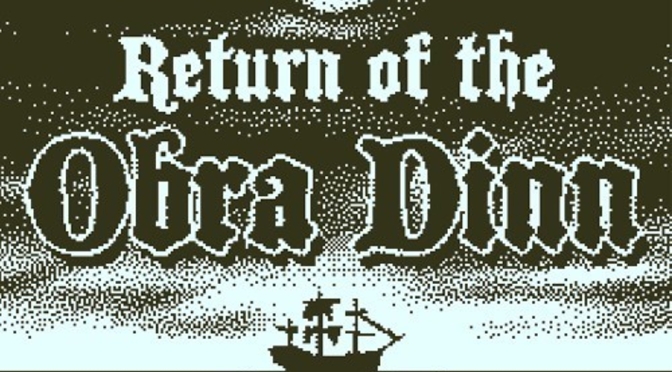
Considering I finished Return of the Obra Dinn a couple of months ago now, this review isn’t particularly timely. A lot has happened in the meantime; most notably my wife gave birth to our first child! The typical rigors of early parenthood – lack of sleep, deciphering the baby’s wants, etc. – have been accentuated by the COVID-19 pandemic, so this will undoubtedly be an especially memorable time for us. Unlike this review however, my playthrough was quite timely. Every year around Halloween, I like to play a thematically appropriate game, and conveniently this particular game, which had been on my radar for a while, was having an anniversary sale. The choice to purchase it was a no-brainer, although the game itself was anything but.
Developed over a handful of years, ostensibly single-handedly by Lucas Pope, Return of the Obra Dinn is quite unique. Set in the early 19th century, I assumed the role of an insurance inspector, tasked by the East India Company to investigate the mysterious return of theObra Dinn. Once again the ship was docked in the Falmouth port from whence it departed a number of years prior, albeit now without any living crew. More specifically, my job was to identify every individual who set foot on the vessel and piece together their fates, such as how they perished and precisely where.

I explored the Obra Dinn from a first-person perspective, searching every nook and cranny for clues. The stark “1-bit” visuals were designed to honor the legacy of Macintosh games from the 1980s and 1990s, and in conjunction with the three-dimensional environment I navigated, were totally mesmerizing. Upon boarding, there wasn’t much for me to find, save for a few corpses. I couldn’t do much with them, until I opened the box that was sent with me. Inside was a book and a pocket watch. The book, in addition to having reference material like a passenger manifest and definitions, told the story of the Obra Dinn, although it was mostly blank at this point. And the pocket watch, well it was special. Dubbed the Memento Mortem by an accompanying letter, it could be activated by a corpse to go back in time and witness the moment of death.
With these two objects, I began to unravel the mysteries of the Obra Dinn. As I learned who was who, their status, relationships, and how they died, the larger question of what happened aboard the ship also became clearer. Using the Memento Mortem on a particular corpse often opened up a daisy chain of other corpses to review, allowing me to witness in reverse a conflict or event that resulted in multiple deaths. In doing so, the book was filled in chapter by chapter, although they weren’t complete until I had successfully guessed the related parties and their fate. It was possible to decipher each outcome through logic alone: what was the individual wearing, where were they, did I see them with certain people in other scenes, etc. Helpfully, once I had guessed three fates correct, the game alerted me and they were locked in.

Slowly chipping away at the fates of those on the passenger manifest, and cracking the case of the Obra Dinn was immensely satisfying. By watching scenes of death over and over, I’d pick up on contextual clues that I’d missed earlier. “Oh, this person was alongside this guy again. They must have related job duties!” Through logic and a process of elimination I could confidently determine fates, which wasn’t too dissimilar from solving puzzles in a Sudoku or Picross game. This hard logic gameplay would’ve been enough to keep me engaged to see the ending, but the non-linear fashion in which I examined corpses and unraveled the story kept me somewhat in the dark on what exactly transpired until the game’s conclusion. It was a mystery I wanted to see revealed, and it truly felt like I pieced it all together with my own deductive powers.
